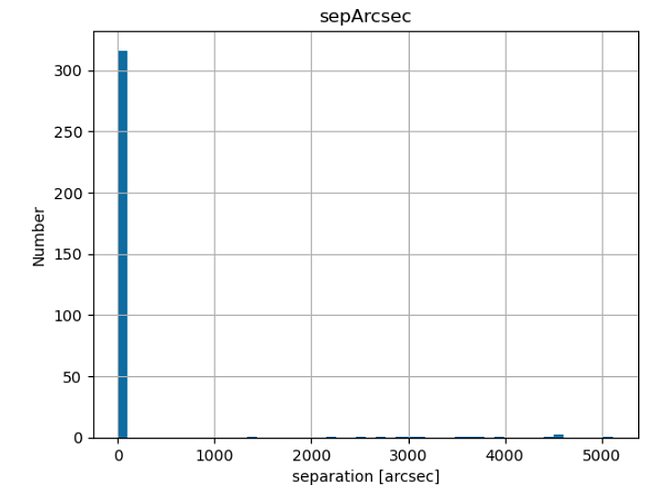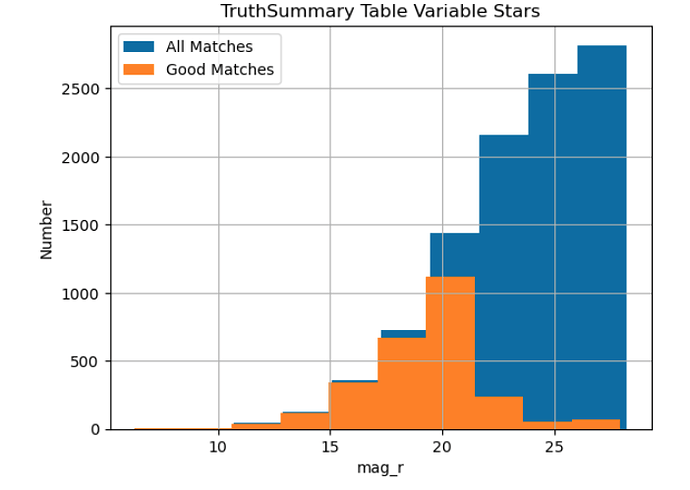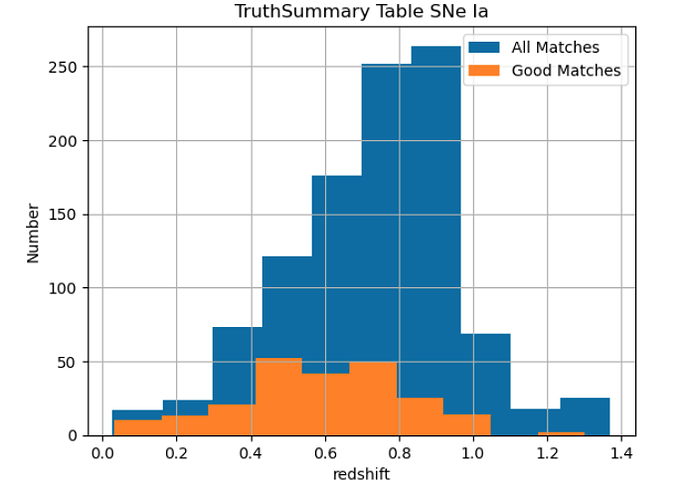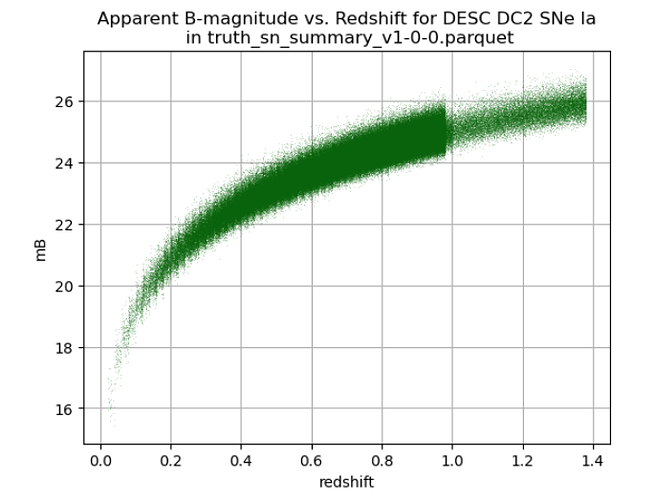Hi, Akshita! I am just writing down some (I hope) final thoughts; so we can declare this issue resolved.
I see 2 related but opposite concerns:
- Does the catalog of candidate SNe Ia from DP0 Tutorial Notebook 7a find the SNe Ia from the DESC Data Challenge 2 Truth Tables? I.e., are the candidates found in the DP0.2 DiaObject and DiaSource tables via the back-of-the-envelope method identify the True SNe Ia from the DC2 Truth Summary table?
- Does the catalog of True SNe Ia (and True variable stars) from the DC2 Truth Summary have corresponding entries identified in the DIA processing ? I.e., do the True SNe Ia and variable stars in the DC2 Truth Summary have matches in the DP0.2 DiaObject/DiaSource tables?
For both cases, it is necessary to match the catalogs from the DiaObject/DiaSource tables with catalogs from the DC2 TruthSummary table. I showed some of my analysis in previous replies above. Since those replies, I have created a cleaned-up notebook (dia_match_truth.ipynb), which I have pushed to the DP0.2 delegate contributions GitHub repository .
For the first concern ("[A]re the candidates found in the DP0.2 DiaObject and DiaSource tables using the back-of-the-envelope method identify the True SNe Ia from the DC2 Truth Summary table?"), it was found that 313 of the 331 DiaObject/DiaSource candidate SNe Ia identified by this method are indeed well matched (to much better than a 1-arcsec match radius) with SNe Ia from the TruthSummary table. This was done by finding for each DiaOIbject/DiaSource candidate SN Ia its best match in the TruthSummary table; to do this quickly, the astropy match_coordinates_sky function was used. Here is the histogram of separations for 331 DiaObject/DiaSource candidate SNe Ia:
There are clearly some bad matches. Let’s look more closely; further, let’s plot separately the histograms for DiaOIbject/DiaSource candidate SNe Ia whose best match was a TruthSummary variable star and for those whose best match is a TruthSummary SN Ia:
OK, the DiaOIbject/DiaSource candidate SNe Ia whose best match was a TruthSummary variable star are all over the place. Clearly these are overwhelmingly mis-matches. Those whose best match was a TruthSummary SN Ia are pretty heavily clustered near 0 arcserc. One can make ever more zoomed in histogram plots, but it soon becomes apparent that a match radius of 1.0 arcsec is a pretty reasonable value for the cutoff for a “good match.” Here is the zoomed in histogram plots out to a match radius of 1.0 arcsec:
Looks pretty good! There are three good matches to TruthSummary table variable stars, with the overwhelming majority of the good matches being to TruthSummary table SNe Ia. If we count the number of these good matches to TruthTable SNe Ia, we find 313, out of a total number of 331 DiaObject/DiaSource candidate SNe Ia. In other words, about 95% of the candidate SNe Ia identified from the back-of-the-envelope method described DP0.2 Tutorial Notebook 7a turned out to be TruthSummary SNe Ia.
One final plot for this first concern is a plot of the redshifts of these 313 verified candidate SNe Ia:
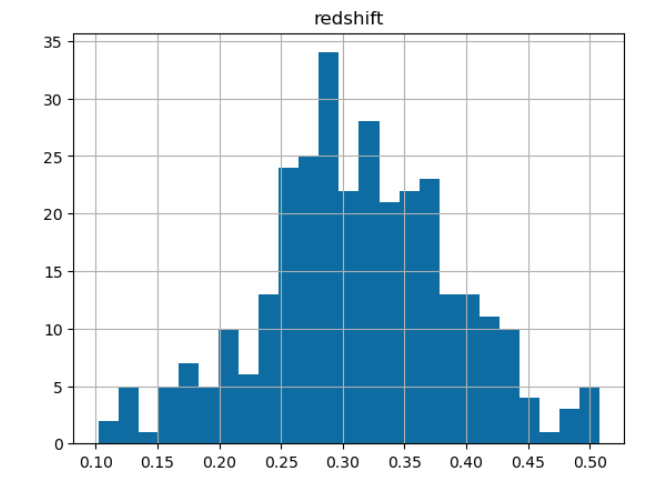
As expected from the NB07a methodology, these are all relatively low redshift SNe Ia.
Now for the second concern ("[D]o the true SNe Ia and variable stars in the DC2 Truth Summary have matches in the DP0.2 DiaObject/DiaSource tables?"). To address this concern, the DP02. delegate contribution notebook dia_match_truth.ipynb downloads all 11,325 TruthSummary entries classified as variables within a ~0.5 sq deg patch (61.0<=RA<=62.0, -33.0<=DEC<=-32.), downloads all 100,643 objects within that same sky area from the DiaObject table, and then finds the best match for each entry the downloaded TruthSummary catalog within the downloaded DiaObject catalog. The resulting matched catalog has 11,325 (since the search was for the best match for each TruthSummary entry).
Since the TruthSummary table is much deeper than the DiaObject catalog, we expect a lot of poor matches. As before, we will denote a good match as one with a separation of less than 1.0 arcsec. Let’s first look at teh TruthSummary variable stars. We will plot the r-band magnitudes from the TruthMatch table for all matches (blue) and for just good matches (orange):
Note that the mag_r of good matches peaks at about mag_r=21, whereas the distribution of mag_r's for all matches continues up to around mag_r=28.
The TruthSummary table unfortunately does not record the values of mag_r for SNe Ia. The Truth apparent magnitudes for the SNe can be found by other ways, but, to keep to just the TruthSummary table, we can plot the histogram of redshifts, instead. Here, we plot the redhifts from the TruthMatch table for all matches (blue) and for just good matches (orange):
The plot for the SNe Ia is not as definitive as for the variable stars, but it is still suggestive. The good matches (separation radius less than 1.0 arcsec) peak at a lower redshift than do the full sample of matches, presumably because the good matches have brighter apparent magnitudes.
To get another look at the True SNe Ia, we can consult the additional Truth table, truth_sn_summary_v1-0-0.parquet, provided on the RSP for DP0 Delegate use by Jim Chiang. We access this table on the DP0 RSP in the following manner:
pfnm_sn_sum = '/project/jchiang/Run2.2i/truth/SNe/truth_sn_summary_v1-0-0.parquet'
result_sn_sum = pd.read_parquet(pfnm_sn_sum)
We can then plot not only the redshifts of all 405293 SNe Ia in the DESC DC2 catalog, we can also plot the apparent B-band magnitudes (very roughly comparable to the r_mag mags):
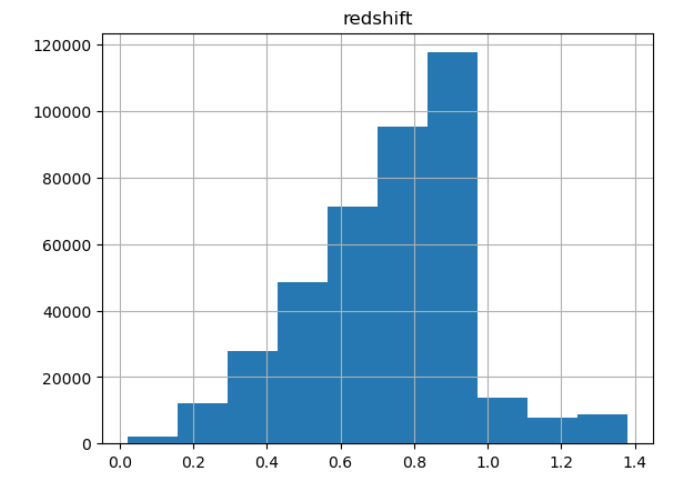
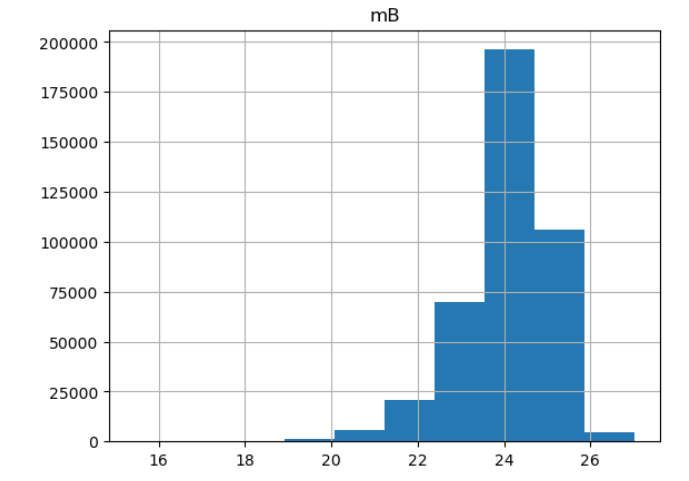
Note the B-band magnitudes (mB) go well below the roughly mag_r = 21 seen for the good matches for TruthSummary variable stars plotted earlier.
Finally, we can also plot the apparent B-magnitude vs. redshift for all the True SNe Ia in truth_sn_summary_v1-0-0.parquet:
The dramatically reduced number density of SNe Ia beyond a redshift of about z=0.95 is feature of the truth catalogs used to generate the DESC DC2, the generation of which is described in LSST DESC et al. (2021).
